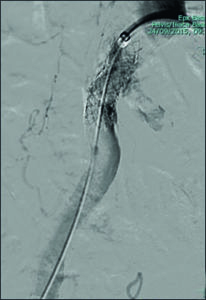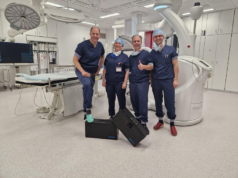This advertorial is sponsored by Bentley.

Maria Antonella Ruffino, a vascular interventional radiologist at Azienda Ospedaliera Universitaria Città della Salute e della Scienza in Turin, Italy, tells Vascular News about her team’s growing clinical experience with covered stents as a platform that offer a minimally invasive solution for arterial emergencies. Ruffino gives an insight into the advantages of covered stents in such cases, their potential limitations, and which ones may be a favourable option for emergency treatment.
Arterial emergencies, such as bleeding, pseudoaneurysm, dissection, or fistula are potentially life-threatening conditions. Spontaneous or iatrogenic arterial emergencies require prompt diagnosis and treatment. During the last few decades, the treatment of these lesions has shifted from emergency open surgery to an endovascular approach, and the latter is rapidly becoming part of the treatment algorithm.
What are the advantages of using covered stents in such emergency cases?
The main endovascular approaches include use of covered stents and embolisation. A key advantage of using a covered stent in an emergency case, when compared to embolisation, is that a stent graft guarantees the immediate exclusion of the lesion without the sacrifice of the target vessel, avoiding the risk of non-target embolisation, which can result in ischaemic complications and rebleeding. Preservation of flow is crucial – particularly in districts with a terminal vascularisation, without collaterals, such as the limbs and kidneys. Additionally, this also applies to the liver, where it is uncertain whether extrahepatic arteries provide sufficient collateral circulation in case of hepatic artery occlusion.
What is your clinical experience with covered stents?
At our centre, we started using the BeGraft peripheral stent graft (Bentley, Hechingen, Germany) in June 2015. In the beginning, we used it for iliac procedures in elective cases of severe aortoiliac occlusive disease. Subsequently, we expanded this to include cases of rupture or dissection, and for severe complications that can present when long, calcified iliac occlusions are treated. The availability, wide sizing range, good trackability and conformability of these stent grafts and their low profile (6F compatible up to 8mm diameter) led us to extend their use to other vessels in case of arterial injuries. Since 2018, we have also used the BeGraft aortic stent graft, which has allowed us to treat vessels of larger diameters. Our cardiology colleagues already use the BeGraft coronary stent.
During the last few years, we have treated many emergency cases with the BeGraft stent graft family. These include iliac ruptures or renal pseudoaneurysms – which are quite common – but also more complex cases, like common carotid artery bleeding or penetrating aortic ulcer rupture*. In these last two scenarios, in particular, where we needed a large stent graft (Ø12mm), we have experienced first-hand how a larger diameter BeGraft stent can perform in tortuous anatomies, thanks to its good trackability and low profile, as it can be used with small vascular sheaths (9F in these cases).
Part of our experience, which focused on iatrogenic arterial injuries, has been recently published in Medicine, reporting a technical success of 100% and a clinical success of 88%. No device- or procedure-related deaths, nor major complications were reported. There was no patency loss at mid-term follow-up (average FU 390 +/- 168 days).1
Are there any limitations associated with the use of covered stents for emergency cases?
Almost all arterial lesions can be treated with covered stents, except for those without anatomic suitability, such as very distal lesions, or those without an adequate proximal and distal neck. Similarly, arterial lesions that are located in vessels of a calibre not suitable for stenting cannot be treated with covered stents. Finally, in case of tortuous anatomy or at a joint, when possible, a self-expandable covered stent is the preferred option.
What are your must-have sizes of covered stents for emergencies?
Arterial emergencies can present with a variety of lesions that can be very different in aetiology and characteristics, and located in vessels that can vary significantly in size. This is why we require a wide array of differently sized stent grafts in order to select the most suitable one. It is, therefore, difficult to say which sizes are a “must-have”.
Our experience shows that, in the case of arterial injuries, the proper sizing of the stent graft is essential to achieve technical and clinical success, without complications and recurrences, which further highlights the importance of having a wide range of stent grafts on shelf to treat arterial emergencies, and the BeGraft family has the broadest covered stent platform in the market.
Overall, endovascular treatment with BeGraft covered stents, with preservation of distal flow, is minimally invasive, safe, and effective in the management of arterial injuries and emergencies. Furthermore, all the aforementioned device characteristics allow for the rapid treatment of the lesion, even in case of tortuous anatomy.
*The usage of the BeGraft aortic foot the treatment in the carotid artery or PAU is off-label
References
- Ruffino MA, Fronda M, Varello S, et al. Emergency management of iatrogenic arterial injuries with a low-profile balloon-expandable stent-graft: Preliminary results. Medicine. 2020 April; 99(15): p e19655
Case images














